TUCSON MOUNTAINS NEWS RELEASES
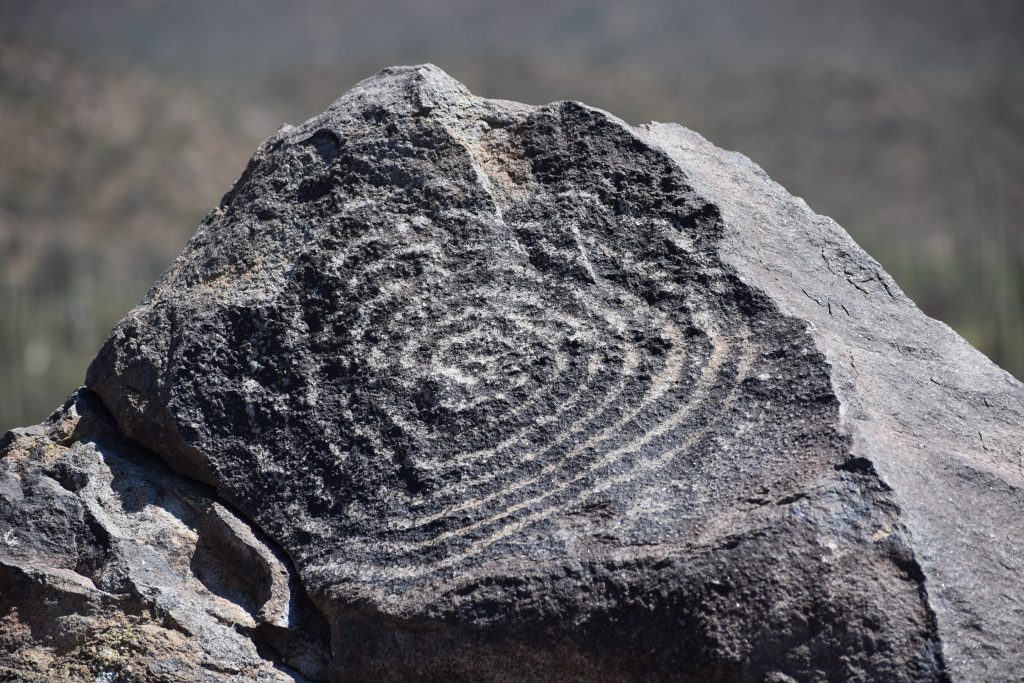
The ancient Hohokams created petroglyphs that connect you to Southern Arizona’s past.
In the Tucson Mountains, Social Media
is Over 1,000 Years Old
TUCSON, AZ, UNITED STATES, April 21, 2021 /EINPresswire.com/ —
Long before Facebook, TikTok, and the Internet, the first settlers in the Tucson Mountains had their own methods of social networking. Native Americans, called the Hohokams, created Petroglyphs. Petroglyphs are rock carvings made by pecking directly on the rock surface using a stone chisel and stone hammer. When the desert varnish (or patina) on the surface was chipped off, the lighter rock underneath was exposed, creating the petroglyph.
The petroglyphs in the Tucson Mountains were left by the ancient Hohokams as early as AD 850. They used rock art to tell stories or record important events. Other purposes could have been boundary markers for hunting or landmarks and clan symbols. They also included fertility and spiritual symbols along with solstice and calendar markers. Images and icons are often animals, humans, plants, astrological objects, and abstract designs, including spirals and squiggly lines. Historians and archaeologists can speculate what they mean, but the actual stores are lost with the people that drew them. The name Hohokam is interpreted
as mean “those who have vanished.” And unfortunately, the true interpretation of their petroglyphs vanished with them.
There are 21 known petroglyph sites in the Tucson Mountains. Three of the most popular and accessible sites are detailed below.
The Signal Hill Petroglyphs site is located in the Saguaro National Park – West. There are dozens of images viewable from a short trail and viewing area. Look at the images up to the left as you start to climb the trail; they are commonly missed. A large spiral image, a favorite among photographers, is at the top of the hill’s viewing area. The panoramic view of Wasson and Sanford Peak over the dense Saguaro forest is incredible.
The Redemptorist Renewal Center site is located on private property and is a unique location for solitude, reflection, and prayer. It is estimated there are between 800 and 1,000 individual petroglyphs on the hill. A large spiral petroglyph is a calendar marker that displays sunlight interactions on the summer solstice and the spring and autumn equinox days. Please check-in at the Center office or call 520-744-3400 before visiting.
The Kings Canyon Trail site is located within the Saguaro National Park – West. The trailhead is located across the street near the entrance to the Arizona Sonora Desert Museum. The trail is an old mining road, and the petroglyphs are about a mile up the trail before the Mam-AGah Picnic Area. The picnic area has a stone building built by the Civilian Conservation Corps in the early 1030s. There are dozens of images, but the site is not marked and can be easily missed.
PROTECT AND RESPECT THE PETROGLYPHS. Please do not touch the petroglyphs. The oil from your hand can harm the image. Please stay on the trail and do not climb on the rocks.
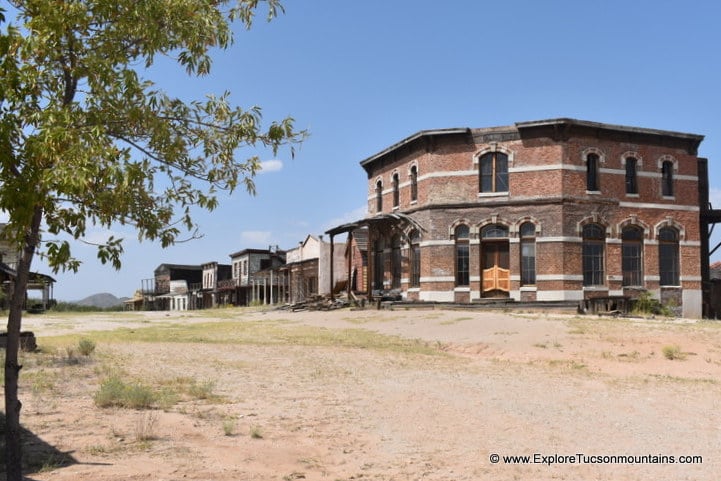
A piece of western movie heritage is saved for future generations.
The Historic Mescal Western
Movie Set Rides Again!
MESCAL, ARIZONA, UNITED STATES/EINPresswire.com/March 29, 2021/News Release
Kartchner Ventures has announced it has acquired the rights and is reopening the western Mescal Movie Set. Mescal was the sister location of Old Tucson Studios, which closed in 2020 due to Covid.
The Mescal set is located outside of Benson, Arizona. It was a popular site for western movies because of its isolated desert location surrounded by mountain backdrops. The earliest movie filmed at the site was Winchester ’73, with James Stewart. At the time, the area was called the Happy Valley set. Old Tucson Studios bought the set from CBS after the filming of Monte Walsh and renamed it Mescal.
Western movie aficionados will recognize the location from many classic westerns filmed there, including:
Tombstone, 1993,
starring Kurt Russell, Val Kilmer, and Sam Elliott
The Quick and the Dead, 1995,
starring Sharon Stone, Russell Crowe, Leonardo DiCaprio, and Gene Hackman
Tom Horn, 1980,
starring Steve McQueen, Richard Farnsworth, and Linda Evans
Outlaw Josie Wales, 1976,
starring Clint Eastwood, Chief Dan George, and Sondra Locke
The Life and Times of Judge Roy Bean, 1972,
starring Paul Newman, Ava Gardner, and Victoria Principal
Monte Walsh, 1970,
starring Lee Marvin, Jeanne Moreau, and Jack Palance
Kartchner Ventures has a plan to rebuild the western town and bring back the filming of great pictures. It will also open the set for public tours. Dates and additional information will be available soon. www.facebook.com/mescalmovieset
Coal Creek Marketing is not affiliated with Kartchner Ventures or the Mescal Movie Set.
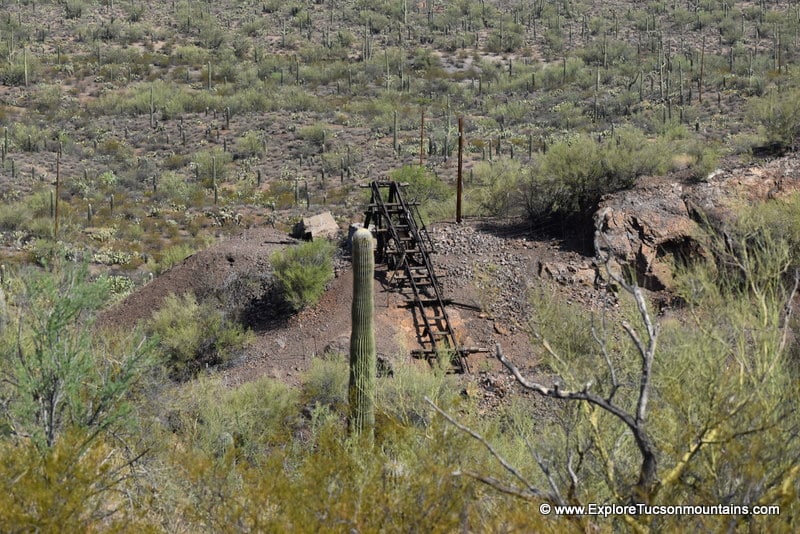
The ancient Hohokams created petroglyphs that connect you to Southern Arizona’s past.
In the Tucson Mountains, Social Media is Over 1,000 Years Old
TUCSON, AZ, UNITED STATES, April 21, 2021 /EINPresswire.com/ —
Long before Facebook, TikTok, and the Internet, the first settlers in the Tucson Mountains had their own methods of social networking. Native Americans, called the Hohokams, created Petroglyphs. Petroglyphs are rock carvings made by pecking directly on the rock surface using a stone chisel and stone hammer. When the desert varnish (or patina) on the surface was chipped off, the lighter rock underneath was exposed, creating the petroglyph.
The petroglyphs in the Tucson Mountains were left by the ancient Hohokams as early as AD 850. They used rock art to tell stories or record important events. Other purposes could have been boundary markers for hunting or landmarks and clan symbols. They also included fertility and spiritual symbols along with solstice and calendar markers. Images and icons are often animals, humans, plants, astrological objects, and abstract designs, including spirals and squiggly lines. Historians and archaeologists can speculate what they mean, but the actual stores are lost with the people that drew them. The name Hohokam is interpreted
as mean “those who have vanished.” And unfortunately, the true interpretation of their petroglyphs vanished with them.
There are 21 known petroglyph sites in the Tucson Mountains. Three of the most popular and accessible sites are detailed below.
The Signal Hill Petroglyphs site is located in the Saguaro National Park – West. There are dozens of images viewable from a short trail and viewing area. Look at the images up to the left as you start to climb the trail; they are commonly missed. A large spiral image, a favorite among photographers, is at the top of the hill’s viewing area. The panoramic view of Wasson and Sanford Peak over the dense Saguaro forest is incredible.
The Redemptorist Renewal Center site is located on private property and is a unique location for solitude, reflection, and prayer. It is estimated there are between 800 and 1,000 individual petroglyphs on the hill. A large spiral petroglyph is a calendar marker that displays sunlight interactions on the summer solstice and the spring and autumn equinox days. Please check-in at the Center office or call 520-744-3400 before visiting.
The Kings Canyon Trail site is located within the Saguaro National Park – West. The trailhead is located across the street near the entrance to the Arizona Sonora Desert Museum. The trail is an old mining road, and the petroglyphs are about a mile up the trail before the Mam-AGah Picnic Area. The picnic area has a stone building built by the Civilian Conservation Corps in the early 1030s. There are dozens of images, but the site is not marked and can be easily missed.
PROTECT AND RESPECT THE PETROGLYPHS. Please do not touch the petroglyphs. The oil from your hand can harm the image. Please stay on the trail and do not climb on the rocks.

The mines were largely unproductive but kidnapping, embezzlement, and bankruptcies made headlines
The Scandalous History of Mining
in the Tucson Mountains
TUCSON, AZ, UNITED STATES, March 24, 2021 /EINPresswire.com/News Release
The Tucson Mountains were once extensively prospected for copper, silver, and gold. The Mountains are the remains of a massive collapsed volcano. Masses of granite and quartz veins are apparent throughout the area, and the possibility of valuable minerals led to prospecting. Early mining activity started in the 1690s after the founding of San Xavier Mission. The first mining claim, The Nequilla Mine, was staked in 1867. The Amole Mining District was created in the early 1870s and encompassed the Tucson Mountains. It was one of the earliest recorded mining districts in North America.
Between the 1890s and the First World War, numerous mining ventures scoured the Tucson mountains looking for copper, silver, gold, and other minerals. The area has over 200 prospector pits and abandoned mines, along with numerous mining camps’ scattered remains. Unfortunately, the excavations yielded low-grade ore, and the cost of operations far outweighed the mineral wealth. More money was made by zealous mine owners falsely promoting unproductive mines to unknowing investors.
Three of the more prominent mines have storied histories that include kidnapping, embezzlement, and bankruptcies.
- Old Yuma Mine was the most successful mine in the Tucson Mountains. The original claim dates back to 1872, and it was the last mine in the area to close in 1947. Copper, silver, gold, and other commodities were mined from this location. During World War I, Molybdenum (used for hardening steel) was mined, and the owners added a mill and smelter, which ran until 1920. Attempts to reopen the mine in the 1980s failed because of legal battles, and Saguaro National Park acquired the property in 2001. The mine is better known for its museum-quality, orange-red wulfenite crystals and an exciting kidnapping in the early 1930s. In 1932 Cliff Adkins kidnapped Tucson banker Gordon Sawyer for a $60,000 ransom. The local deputies were able to track the abductor and rescue Mr. Sawyer from an abandoned well at a local ranch. However, Adkins escaped and hid at the Old Yuma Mine, forcing the owner, “One-Eyed” Joe Baker, to feed him. Mine caretakers reported Atkins to authorities, and the Tucson Police and Border Patrol eventually apprehended the kidnapper.
- The Mile Wide Mine was initially named the Copper King Mine. George Reininger purchased the mine from the original owner, L. Martin Warer, in 1915. He changed the mine’s name to Mile Wide Mine because that was the width of the entire claim. Reininger invested in the mine, building a workshop, mess house, rock crusher, and mill. He also developed an access road into the mountains, which is now part of the King Canyon Trail system. The Mile Wide mine extracted 70,000 pounds of copper and silver; however, Reininger sensationalized his findings to investors. In 1919 he disappeared with the investors’ money and $100,000 from selling his shares of stock. Several other owners worked the mine until it closed permanently in 1942.
- The Gould Mine was established in 1906 by S.H. Gould. He sensationalized the findings indicating the mine contained a mother lode of copper. It did produce 45,000 pounds of copper, valued at $9,000 at that time. After several years the company went bankrupt and ceased operations in 1911. During the 1950s, attempts were made to reopen the mine as an open-pit operation. Local opposition prevailed and the property eventually became part of Saguaro National Park. It is currently classed as an archaeological site by the National Register. An iron grate covers the pit, and the powder house walls still stand. Foundations for the blacksmith shop and mess hall also remain. Samples of azurite, epidote, garnet, malachite, and pyrite originating from the mine tailings can be found along the trail. The mine tailings can be seen from Kinney Rd north of the AZ-Sonoran Desert Museum.
WARNING! Abandoned mine sites are a GREAT safety hazard. The dangers include old explosives, hazardous chemicals, bats, bees, snakes, mountain lions, and other predators. Falls and cave-ins are common. Entry into these mines is prohibited and strongly discouraged.
For more information on abandoned Tucson Mountain mines and the trails that lead to them, visit www.ExploreTucsonMountains.com.
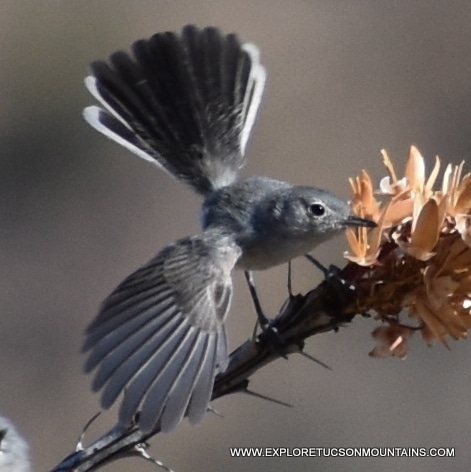
Which state has the highest species list of any state without an ocean coastline?
Arizona with over 560 species.
Now’s the Time to Schedule the ULTIMATE Birding Trip and Vacation to Tucson and
Southern Arizona
TUCSON, AZ, UNITED STATES, February 23, 2021 /EINPresswire.com/News Release
Combine your next bird-watching trip with a “regular vacation” in Tucson and Southern Arizona. Southern Arizona is considered one of the three best birding locations in North America. Tucson is a haven for historical and cultural attractions, along with an abundance of outdoor activities.
The diversity of birds are attracted by the varied elevations, lush Sonoran desert, and migratory flyways from south of the border. Migration schedules impact the diversity of species. Wintering birds begin leaving in late February, and desert resident birds are nesting in March. The best birding season is between mid-April and mid-May, when millions of songbirds make their way north.
Listed below are 5 “combo locations” in which you can visit a birding hotspot along with a unique local attraction. It is perfect for birders traveling with someone more interested in museums, attractions, and other activities.
1. AZ-Sonora Desert Museum and Saguaro National Park-West
The Arizona-Sonora Desert Museum is unlike any museum you have ever visited. It combines a zoo, aquarium, botanical garden, natural history museum, publisher, and art gallery, all in a single location. Plus, 85% of the attractions are outdoors. Two miles of walking paths connect natural displays of plants and animals native to the Sonoran Desert.
Species Sighted — 170
Common Sightings — Gila Woodpecker, Gilded Flicker, Verdin, Black-Tailed Gnat Catcher, Cactus Wren, Curved-bill Thrasher, Phainopepla, Canyon Towhee, Abert’s Towhee, Pyrrhuloxia, and many others.
Saguaro National Park and it’s Red Hills Visitor Center provide spectacular views of mountains and Saguaros right from its shaded back porch. The center has cultural and natural history exhibits of the Sonoran Desert.
Species Sighted — 170
Common Sightings — Rufous-winged Sparrow, Lesser Goldfinch, Costas Hummingbird, Gambel’s Quail, Turkey Vulture, Red-tailed Hawk, Gila Woodpecker, Gilded Flicker, American Kestrel, Verdin, Cactus Wren, Curved-bill Thrasher, Black-Throated Sparrow, Pyrrhuloxia, and many others.
2. Sweetwater Wetlands and Reid Park
Sweetwater Wetlands is a magnet for local and migrating birds. The park uses reclaimed water to create a riparian habitat. It serves as an environmental education facility and habitat for a wide variety of wildlife. It has more than 2.5 miles of pathways that visit several ponds surrounded by cattails, willows, and cottonwoods.
Species Sited — 309
Common Sightings — Vermilion Flycatcher, Black Phoebe, Abert’s Towhee, various wrens and warblers, Cooper’s, Red-tailed, and Harris Hawks, Greater Roadrunners, Red-winged, Yellow-headed and Brewer’s Blackbirds, various waterfowl, and many others.
Reid Park is a 131-acre park that includes a 24-acre zoo, baseball stadium, an outdoor performance center, two lakes, public pools, along with playgrounds, gardens, and picnic areas.
Species Sited — 239
Common Sightings — Anna’s, Black-chinned, Broad-billed & Costa’s Hummingbirds, Cooper’s, Red-tailed, & Harris’s Hawks, Gila & Ladder-backed Woodpeckers, Black & Say’s Phoebes, Vermillion Flycatcher, Cassin’s & Western Kingbirds, Yellow Warbler, and various waterfowl.
3. Sabino Canyon and Tanque Verde Wash
Sabino Canyon is a popular recreational area in the eastern foothills of the Catalina Mountains. The canyon is known for it’s stunning vistas, deep canyons, and waterfalls along Sabino Creek. A tram climbs up into the canyon with trailside interpretive information. There are miles of hiking trails that take you into the backcountry.
Species Sited — 205
Common Sightings — Phainopepla, Vermilion Flycatcher, Cactus Wren, Elf, Western Screech, & Great Horned Owls, Common Poorwill, Gambel’s Quail, Curved-bill Thrasher, Black-throated Sparrow, Greater Roadrunner, Rufous-crowned & Black-chinned Sparrows, and many others.
The Tanque Verde Wash is a convenient metropolitan Tucson birding location. Still, you’ll feel like you are far off the beaten path. The wash is dry most of the year but flows during the summer monsoon season. The area provides a beautiful habitat resource for native riparian birds and migratory birds, and other wildlife. It also acts as a travel corridor for wildlife.
Species Sited — 217
Common Sightings — Phainopepla, Vermilion Flycatcher, Northern Beardless-Tyrannulet, Purple Martin, Summer & Hepatic Tanager, Bell’s Vireo, Yellow-breasted Chat, Blue Grosbeak, Chipping Sparrow, Green-tailed Towhee, Orange-crowned Warbler, and many others.
If you have some extra time, plan a day trip to popular birding sports south of Tucson.
4. Madera Canyon and Canoa Ranch Conservation Park
Madera Canyon is one of the most famous birding areas in Arizona and the United States. The canyon is a riparian woodland with a shallow permanent creek. It is on the northern slopes of the Santa Rita Mountains south of Tucson. The canyon is a favorite area for birders, along with hikers, photographers, artists, and locals escaping the heat.
Species Sited — 220
Common Sightings: Black-crested Titmouse, Cedar Waxwing, Chipping Sparrow, Western Wood-Pewee, Broad-tailed, Ruby-throated, Black-chinned, & Rufous Hummingbirds, Violet-green Swallow, Pygmy Nuthatch, and many others.
Canoa Ranch Conservation Park is 4,800 acres of the original San Ignacio de la Canoa Grant and is listed in the National Register of Historic Places. Educational tours are available, including bird walks and stargazing events.
Species Sited — 268
Common Sightings — Tree Swallow, Cliff Swallow, Vesper Sparrow, Northern Rough-winged Swallow, Violet-green Swallow, Chihuahuan Raven, American Wigeon, Black-throated Sparrow, White-crowned Sparrow, and many others.
5. Ramsey Canyon and Patagonia Lake State Park
Ramsey Canyon Preserve surrounds a spring-fed stream within high canyon walls providing a moist, cool environment. The 280-acre preserve offers a haven for 14 species of hummingbirds. Inside the Visitor Center is the kid-friendly Please Touch Room with bird nests, snake skins, and other wildlife bits.
Species Sited — 211
Common Sightings — White-crowned Sparrow, Hermit Thrush, Sulphur-bellied Flycatcher, Bridled Titmouse, Acorn Woodpecker, Broad-billed, Ruby-throated, Black-chinned & Rufous Hummingbirds, Ruby-crowned Kinglet, Plumbeous Vireo, Cordilleran Flycatcher, Red-faced Warbler, Western & Hepatic Tanager, and many others.
Patagonia Lake State Park is a state park containing a 2.5-mile-long, 250-acre lake. It is a popular site for fishing, camping, boat rental, picnicking, hiking, and birding.
Species Sited — 323
Common Sightings — Pine Siskin, Horned/Eared Grebe, Lesser Goldfinch, Bufflehead, Mexican Duck, Spotted Sandpiper, Black-necked Stilt, Lincoln’s Sparrow, Montezuma Quail, Ruby-crowned Kinglet, Lark Bunting, Nashville Warbler, Western Bluebird, Black-headed Grosbeak
Lesser Scaup, and many others.
Before planning your trip visit these recommended websites:
www.tucsonaudubon.org/
www.ExploreTucsonMountains.com
www.ebirdhotspots.com/birding-in-arizona
For more information on visiting, hiking, and birding in the Tucson Mountains, go to www.ExploreTucsonMountains.com.
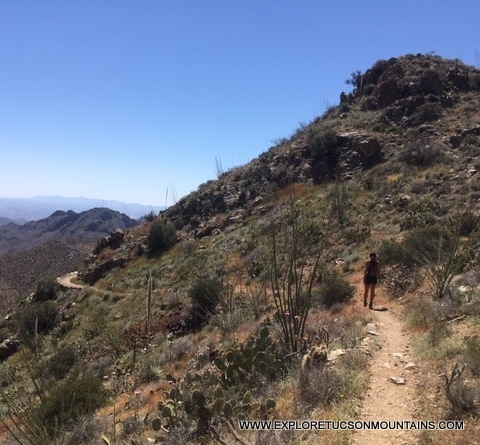
Regardless of interest, conditioning, and experience, there is a trail for you in the Tucson Mountains.
7 Reasons to Hike & Explore
the Tucson Mountains
TUCSON, ARIZONA, UNITED STATES, January 27, 2021 /EINPresswire.com/News Release
Do you love to hike? The Tucson Mountains, with its lush Sonoran Desert landscape and volcanic rock formations, is one of the most unusual hiking locations in the country. For nearly 100 years, hikers from all over the world have enjoyed the 150+ trails that criss-cross this range through local and national parks. Surrounded in a setting so spectacular, it has appeared in more than 400 movies and TV shows.
1. ADA Accessible and Interpretive Trails
Feliz Paseos Park is the first park in Arizona, and one of the first in the country, focusing on universal accessibility. The 56-acre park features a handicapped-accessible trail system with interpretive signs. It includes a paved parking area, a plaza with a large covered ramada, and two ADA accessible family restrooms.
2. Bring Fido! There Many Are Dog-Friendly Hiking Locations
Tucson was rated the most dog-friendly city in America in 2018. Two of the most popular dog-friendly parks are The Sweetwater Preserve and Feliz Paseos Park. Sections of Tucson Mountain Park are open to leashed dogs, including Enchanted Hills Trails Park and The Robles Pass Trails Park.
3. Unusual and Historical Destinations Are a Short Hike Away
The Picture Rocks Trail will lead you to thousand-year-old petroglyphs carved in stone by the Hohokam Indians. There are 21 known petroglyph locations in the Tucson Mountains.
The Gould Mine Trail will take you to a 100+-year-old abandoned mine now located in Saguaro National Park. An iron grate covers the mine shaft, and the powder house walls still stand. Foundations for the blacksmith shop and mess hall also remain.
The Yetman Trail passes one of the most popular destinations in the Tucson Mountains; the Bowen Homestead ruins built in the 1930s. The home had numerous large windows, two fireplaces, and a bathtub. Only the walls stand today because a fire consumed the roof and interior in 1970.
4. There Are Trails for Everyone
Regardless of skill, conditioning, and experience, there is a trail for you in the Tucson Mountains.
Hikers looking for a cardio workout can take the Sweetwater Trail to Wasson Peak, the highest peak in the range. Or, they can climb the short, steep Tumamoc Trail for a panoramic view of the city.
For those looking for a moderate workout, the new Painted Hills Park has approximately 4 miles of trails and is known for its picturesque stands of saguaros and many peaks.
The Saguaro National Park-West offers two easy, kid-friendly trails. The Desert Ecology Trail and the Desert Discovery Trail are close to the park’s Visitor Center . . . and it’s restrooms.
5. The Lush Sonoran Desert
The Tucson Mountains are located in the Sonoran Desert, which is considered the wettest desert in the world. Also, it’s the only place in the world where the Saguaro Cactus grows in the wild. Known as the west’s universal symbol, the Saguaro is the largest cactus found in the United States.
6. Unique Arizona Wildlife
The Sonoran Desert is the most biologically diverse desert in North America. The Tucson Mountains are a birder’s paradise with more than 80 birding hot spots. It’s not unusual to catch sight of coyotes, javelina, and mule deer while hiking. Plus, more than 100 different reptiles thrive in this arid environment.
7. Covid
Don’t let the pandemic trap you at home! Hiking is a safe activity to get outside, socially distance, and be active.
For more information on visiting, hiking, and exploring the trails in the Tucson Mountains, go to www.ExploreTucsonMountains.com.
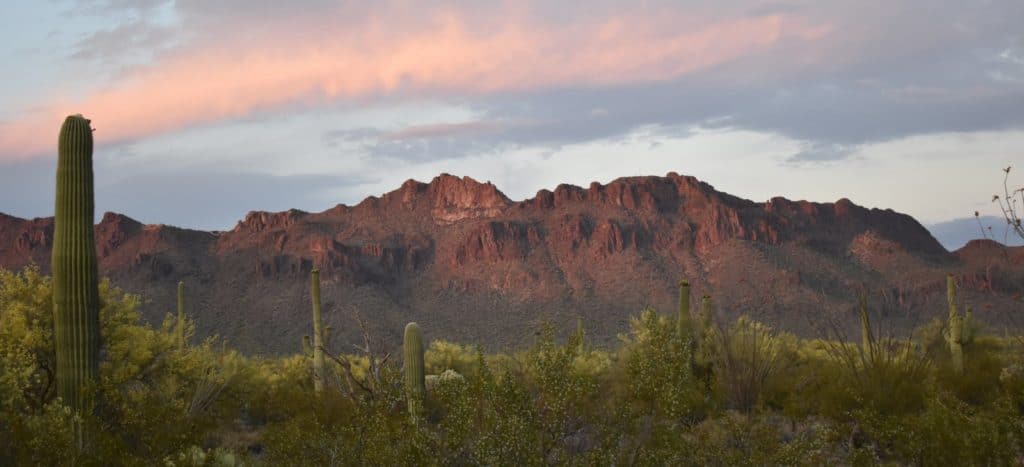
A new travel website offers visitors and residents a comprehensive resource to find unique attractions and outdoor adventures in the Tucson Mountains and Sonora Desert.
Suffering from “Pandemic Boredom?”
Find a Remedy in the Tucson Mountains.
TUCSON, ARIZONA, UNITED STATES, December , 2020/News Release
Tucson, Arizona –In January 2021, a new website, www.ExploreTucsonMountains.com, officially opens, offering visitors and residents a new resource to find unique attractions and outdoor adventures in the Tucson Mountains.
The Tucson Mountains has a rich history of Native American culture, Spanish explorers, and western lore. Plus, it has been a picturesque western backdrop in over 400 movies and TV shows. Today, it is a popular destination for out-of-town visitors and local residents because of its attractions and a wide variety of activities for the outdoor enthusiast. This new comprehensive website enables users to quickly find fun and adventure just a short drive from downtown Tucson. The website profiles:
• Unique Attractions AZ-Sonora Desert Museum, Saguaro National Park-West, San Xavier Mission, and many lesser-known but must-see attractions.
• Outdoor Activities More than 150 hiking/biking trails, horseback riding, rock climbing, hunting, birding hotspots, fishing, golf, and more.
• Out of the Ordinary Adventures Sky diving, hot air balloon rides, helicopter rides, ATV rentals, abandoned mines, Indian petroglyphs, and more.
• Food and Spirits Steak houses, family-owned Mexican restaurants, craft breweries, and a search tool to over 50 tasty places to eat and drink.
• Catch Some Shuteye Bed and breakfasts, resorts/hotels, dude ranches, RV/tent camping, and a search tool to over 40 West Tucson hotels.
Plus an Event Calendar, Wildlife Photo Gallery, Trail Cam Video Gallery, Historical Timeline, Movie Film Locations, Online Store, and 100+ fun activity ideas.
www.ExploreTucsonMountains.com is published by a retired reference book publisher and long time resident of the Tucson Mountains.
